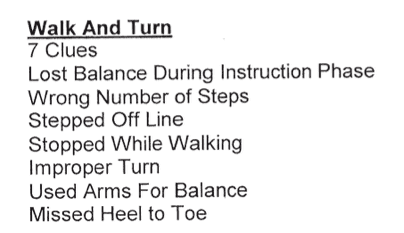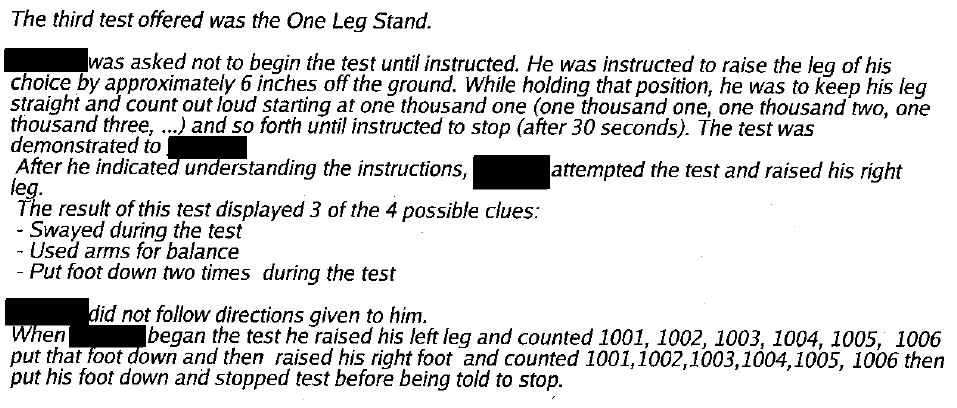The Definitive Guide to Mississippi DUIs - Part 3
Exiting the Vehicle
Now that the police officer has made a decision to ask the driver to step out of the vehicle, the officer begins to pay more attention to the driver’s physical abilities. First, the officer is taught to watch what the NHTSA calls “the exit sequence,” or what normal human beings call “getting out of the car.”
Officers are taught to look for drivers who become angry when asked to step out, can't follow instructions, leave the car in gear, can't open the door, lean against the car, or can't keep their balance without holding onto the car. And if they see any of those things, they add it to their list of reasons why they think the driver is impaired and should note that in their written report.
Standardized Field Sobriety Tests, or "Pre-Arrest Screening"
The next phase of DUI investigation is something the NHTSA calls "Pre-Arrest Screening," which seems by its name to imply that the decision to arrest has been made. "Pre-Arrest Screening" sounds like something an officer does to make sure the person being arrested doesn't have any medical issues, and not to make sure the arrest should happen in the first place. But I digress.
The first step in the "Pre-Arrest Screening" phase is putting the driver through Standardized Field Sobriety Tests (SFSTs), or what a lot of us (law enforcement and lawyers) call "Stupid Human Tricks" after the Dave Letterman bit. The NHTSA's spent a lot of money developing these tests over the years, and they are quick to tout the "success rate" of these tests in identifying impaired drivers. The problem is that these tests were developed in lab or lab-like settings, with sober test subjects (.00-.05% BAC) or very intoxicated ones (.15% or higher BAC). That's not to say that they don't have some validity, but crowing about a test's ability to identify people with a BAC twice the legal limit strains credulity just a bit, doesn't it?
The Horizontal Gaze Nystagmus Test
Anyway, the first of the tests is the horizontal gaze nystagmus test, or HGN. The idea behind this test is that the presence of alcohol or certain drugs in a person's body impacts fine muscle movements, and the eyes are the best place to observe that. The officer starts by having the driver stand still with their eyes watching a small "stimulus", like the tip of a pen, a pencil eraser, or a penlight. Since it's usually dark outside when officers are conducting this test, a penlight is probably the most commonly used.
The officer then tells the driver to follow the stimulus with their eyes only, and to not move their head. They'll say "follow it as far as you can without moving your head," or something similar. The officer is taught to look for bumpy, "jerking" movement in the eyes. This is called horizontal gaze nystagmus, and it can be caused by many things, including high blood pressure, nicotine, antihistamines, and the flu. It can also be caused by the presence of alcohol in the body.
As with the other SFSTs, there are a list of "clues" that the officers are looking for. They are to examine each eye for three clues, always starting with the left eye. The maximum number of clues for each eye is three, so the maximum number of clues on the HGN test is six. The three clues are:
- Lack of smooth pursuit - the driver's eye jumps from point to point instead of smoothly following the pen all the way to the side
- Distinct and sustained nystagmus at maximum deviation - when the driver's eye has gone as far as it can to the side, the eye twitches
- Onset of nystagmus prior to 45 degrees - the driver's eye begins to jerk before reaching a 45-degree angle
There are plenty of reasons to doubt the accuracy of these "clues," but that's what the NHTSA teaches the officers to look for. Typically, an officer's report will read something like this:

Notice how the officer went in order from 1 through 3 with each clue and reported a total of six out of six clues. Also notice how the officer mentions vertical nystagmus. Vertical nystagmus doesn't have the same history of testing that horizontal nystagmus does, but that doesn't stop the NHTSA from mentioning it in their training programs or officers from talking about it in their reports.
The Walk and Turn Test
After the officer conducts the HGN test, they are taught to conduct the Walk and Turn (WAT) test. Like the HGN test, the NHTSA has spent a lot of money over the years testing it out in labs and lab-like settings, and like HGN the NHTSA likes to tout statistics to make people believe the test is more accurate than it is.
The WAT is a divided attention test, the goal of which is to test a driver's ability to balance while processing information. The officer is taught to first go over the instructions with the driver, and then have them perform the test. First, they tell the driver to stand still with their feet heel-to-toe and their arms by their sides as they listen to the instructions. This is not a normal way of standing, of course. The officer then gives the driver the rest of the instructions, and demonstrates it for the driver. This part not only tests the driver's balance, but also his ability to process and remember the instructions. Here are the instructions, which vary slightly from officer to officer:
"You are to take nine heel‐to‐toe steps in a straight line. After the ninth step, you are to turn in the prescribed manner which I will show you in a moment, then take nine heel‐to‐toe steps back down the line. You are to count the steps out loud, and watch your feet the whole time. During the turn, you keep your front foot on the line, and using your other foot to take several small steps to complete the turn. Now I will show you what I am asking you to do."
The NHTSA teaches officers to observe the driver's behavior during this "instruction stage" of the WAT. After the instruction stage, the walking stage begins. During the walking stage, the driver's attention is divided between walking heel‐to‐toe and turning, counting the steps out loud, and remembering the number of steps and how to do the turn properly. It's...a lot.
Officers are taught to look for the eight following clues on the WAT:
- Can't keep balance while listening to the instructions
- Starts too soon
- Stops while walking
- Doesn't touch heel-to-toe
- Steps off the line
- Uses arms for balance
- Makes an improper turn
- Incorrect number of steps
Sometimes the officer gives the results of the WAT in a more narrative format in their reports, but usually it looks like this:

As you can probably guess, a lot can affect a person's balance aside from being intoxicated. Footwear, inner ear issues, the road surface itself, and oncoming vehicles are just a few of the variables that can come into play with this test. The instruction stage can also last a very long time, which can affect a person's ability to stand still. Weather (wind, cold, rain, etc.) can also play a factor as well.
The One Leg Stand Test
The final SFST is the One Leg Stand (OLS) test. Like the other two before it, NHTSA has spent time and money over the years testing this test, and has statistics that show it is 83% accurate. As with the others, there are reasons to doubt those statistics that are beyond the scope of this post.
The One Leg Stand test is what it sounds like. The officer has the driver stand on one leg with their arms at their side and count out loud until told to stop. There is an instruction stage and a "balance and counting" stage. During the instruction stage, the driver has to stand still with their feet together (as opposed to heel-toe like before) with their arms at their side. The officer tells the driver to lift either his left or right foot about 6 inches off the ground with both legs straight and the raised foot parallel to the ground. The driver is then to count out loud "one thousand one, one thousand two, one thousand three" and so on until told to stop. Unbeknownst to the driver, the officer is taught to keep the driver counting to at least "one thousand thirty." If the officer stops the driver before then, the test is significantly less accurate according to NHTSA.
There are four clues the officer is taught to look for during the OLS. They are:
- Swaying while balancing
- Using arms to balance
- Hopping
- Putting the lifted foot down on the ground
Here is an example of a more narrative description of the OLS test results in a Mississippi police report for a DUI arrest:

Other "Tests"
The NHTSA teaches other tests, such as the alphabet test and the counting test, but these are NOT standardized field sobriety tests. In fact, the NHTSA doesn't even call them tests, they call them "techniques." These are not seen that often in practice in Mississippi. Usually the officer sticks to the SFSTs. There are also other tests that an officer trained as a "drug recognition expert" may employ, but those are outside the scope of this post. I'll discuss those in a later post.
In Part 4 of the Definitive Guide to DUIs in Mississippi, we'll discuss the PBT or preliminary breath test. It is often misused by Mississippi officers, and we'll get into that in the next post.

